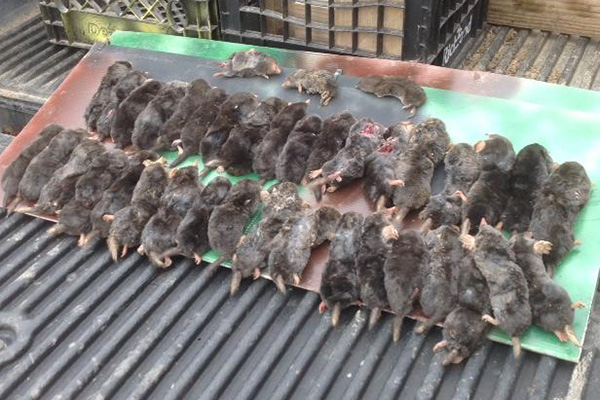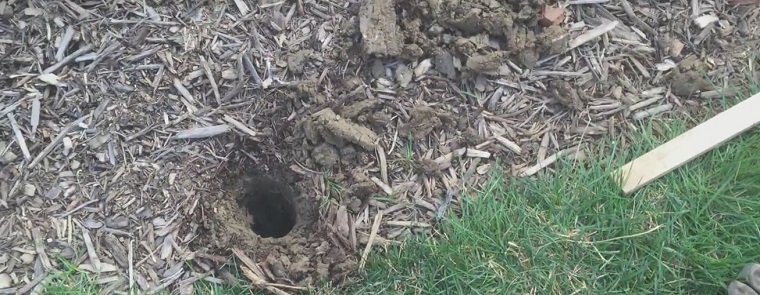-
info@aaanimalcontrol.com
Call us for help in your town
Humane Wildlife Education
Things To Know About Mole Repellent
Need mole removal in your hometown? We service over 500 USA locations! Click here to hire us in your town and check prices - updated for year 2020.
Mole Info: Moles live underground and surface only occasionally. Moles create a complex network of interconnected chambers by burrowing both deep
and close to the surface, where they often leave visible ridges. Mole hills are places where the mole has pushed up earth above
the surface. They have very poor sight and feed mainly on worms and insect larvae that they find by the sense of touch and smell. They will not eat anything that is not alive.

Mole repellent - Many housewives and home owners make it their priority to keep their lawns neat and tidy to also add to the appeal of their homes. After all the time it took for you to grow the perfect green grasses to your landscape what would you do if you suddenly spot a small mound on the ground most probably inhabited by your not mostly liked animal in the world – the pest of a mole? Of course, your first reaction is to chase them away from your beautiful garden but what can you really do about these little animals that spend most of their lifetimes digging holes in the ground?

It is not an easy feat to actually get rid of them once they have started to infest your property, so the best thing to do is prevent them from getting an entry way to your garden. One way of attempting this, as heard around the rumor mill, is through the use of castor oil repellents. They say that these make the moles scramble out of your place. You can easily buy a lot of castor mole repellents in the market or you can make one on your own with the addition of some herbs and spices that you can substitute. However, these products have demonstrated no effect on the behavior of moles.
In other words, they don't work. Of course, you can give them a try - you have to make sure that you reapply them after a rain has washed down all the formula you have sprayed around your premises. It may also want to try, in your testing, to use different types of repellents so they would not be accustomed to the smell and would not get immune to the products that you are using.
Aside from these you can also try to grow varieties of flowers or plants that are not pleasing to the senses of these ground diggers. You can try growing the halcyon, caper spurge or castor beans which produces a pungent smell that could somehow help in eradicating your mole issues. These plants may also help in providing a difficult time for these moles to dig through their tunnels because of the many and complex root networks being grown by these plants.
If in case you already found their tunnels, you can fill them with the homemade repellent you have created or with the spray that you have purchased in the market, such as at Home Dept or Lowe's. This may at least keep them from steadily getting access to your property and might just lure them away in another place where they can safely create their own dwelling and tunnels.
Before you actually try to secure the insides of your property, you better look into trying to exclude them from getting access inside and you can best do that by making a fence out of netted wires, with holes small enough not to let them pass through and it would be recommended that you try to bury at least half of a meter of the wire underground to help keep the moles at bay. If they can’t dig in underground, it would be much harder for them to crawl up the fence right? If you want and if it is allowed in your state you can also try to add in some live wires on your perimeter fence just to scare them away with a little bit of electrocution.
If these would not work, you can buy and set traps, or maybe use fruit gum around your area especially your lawn where you have seen them. If trapping would not work for them then you can always call your local pest exterminator to handle the problem for you. They might as well know what to do with these pests since they
are on that business, otherwise you don’t have much choice than to perhaps spread a few insecticides or pesticides that would surely kill them – again that is, if it is allowed in your local state laws. Read about mole trapping to learn about how
it's done, and please be aware that it isn't easy for amatuers. Mole trapping requires a great deal of experience. You may be wondering if there are other ways outside of trapping to
kill a mole but there really aren't. You'll need lethal traps like spear traps or scissor traps. Finally, are there some ways to modify your
lawn or property? A little. Read about mole prevention here.
Go back to the main how to get rid of moles page for better information.
When you look at removing wild animals from your property or land, you will often find that there are advised repellents and deterrents. Some of these are homemade, some of which can be bought from hardware stores, etc. Some of them can be really expensive too, which is why we feel the need to warn you that many of them don't actually come with the best success rates. In fact, when used alone, as your sole method of mole removal, you will often find that it has zero success at all.

One of the most popular ingredients that we have seen in various mole repellents is castor oil. It is said that moles (and other underground critters) don't much enjoy the smell of castor oil, therefore, causing it to evacuate whatever tunnel system smells of it. Not only that, but consuming castor oil actually makes the animal quite sick. (To be fair, if you consumed castor oil, it would give you an upset stomach too!) Using this theory, by using castor oil sprinkled or drizzled around mole hills and tunnels, you should be able to effectively eradicate the problem from that area.
It’s a pretty natural remedy, which does give you some comfort, but what won't give you any comfort is the fact that it simply doesn't work. Whenever we turn up to a mole removal job, one of the first things we usually hear is, "Oh, I tried using castor oil and flooding the area, but …”. If it worked, we would be out of a job. Our mole removal calls are higher than ever.
Speaking of flooding (which we just did), another recognized method of getting rid of moles is to flood the area. You don't actually need to flood the area, but just make it quite wet — wetter than usual. Again, moles are said not to appreciate the texture of really soft ground, and will therefore find somewhere else to start digging. Wet ground is also quite unstable. The problem with this, of course, is that a good watering (or heavy rainfall) often attracts insects to your yard, including earthworms. Earthworms make up the bulk of the mole's diet, so by over-watering the area, you run the risk of attracting more, not forcing them away.
Flooding is not a great option, not only for the utter waste of water (and cost on your water bills), but also because it makes the land unusable and unsafe for you. The people in your home won't be able to enjoy the garden, because the tunnels and moist ground will have caused areas of instability, and this can lead to twisted and even broken ankles, as well as other injuries. Even animals, such as horses, can fall down an unstable molehill.
Cayenne pepper follows a similar process to the castor oil concoction — providing a solution that doesn’t smell or taste nice to the mole, and we have even heard of people using fruity-flavored bubble gum to repel moles. Sadly, the bubble gum trick DOESN’T repel moles. It kills them. Or, at least, it can. The gum can get stuck in the digestive tract of the mole, causing it to be unable to eat. Either that or it “gums up” their respiratory system and causes them to choke to death, by getting stuck in the throat. This is incredibly inhumane.
If you feel like getting really hands-on this year, one method of mole repellent that can actually work quite well when it is done properly, is to mix in kitty litter or gravel, something scratchy and with an edged-surface, with the mud or soil around your garden. Gravel especially is difficult for the mole to dig through, and it is likely to turn around. Filling mole holes with gravel, especially in high-traffic areas, has been shown to move the mole along a little bit, but you may find that you have to do this a few times before you can finally free your land from the thing.
You could always take the electronic route too. You can buy ultrasonic systems that are design to give off high-pitched sounds and/or vibrations through the ground, all with the aim of deterring a mole and other underground critters. These are often expensive and come with maintenance or running costs that you will also need to take into consideration. With long-term use, many of these repellents can actually prove to be the more expensive (and more time-consuming) options.
There are plenty of mole repellents out there that you could try your hands at. We’ve seen everything from shoving lemons and limes in tunnels, to using weird and wonderful combinations of herbs and spices together. The problem with repelling the animal is that you give it the opportunity to come back, once you stop using the repellent. If you run out of lemons and limes, for example, or have no more castor oil to use, the area is untreated and, therefore, vulnerable.
For more information, you may want to click on one of these guides that I wrote:
How to Get Rid of Moles
how much does mole removal cost?
How to get rid of moles in yard with castor oil
Home remedies to get rid of moles in yard


















